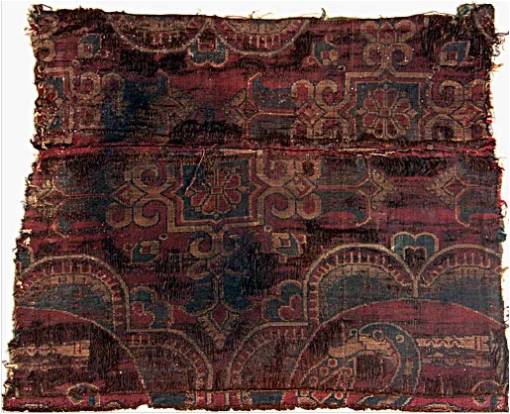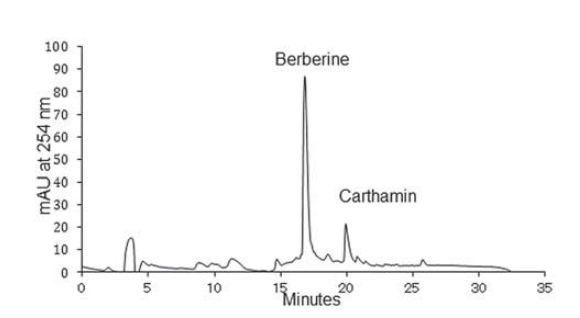Difference between revisions of "CNSM 2703, Samite with bird roundels on a red ground , China (Tang dynasty, 618-907 CE)"
| Line 7: | Line 7: | ||
[[File:CNSM 2703.jpg|center|frame|Image of the samite fragment. © China National Silk Museum, Hangzhou, China ]] | [[File:CNSM 2703.jpg|center|frame|Image of the samite fragment. © China National Silk Museum, Hangzhou, China ]] | ||
| + | |||
| + | == Analytical instrumentation and procedures == | ||
| + | |||
| + | The dye was extracted from a thread (0.2-1mg) of the archaeological object in a solution of pyridine/water/1.0M oxalic acid as described by Mouri and Laursen [2]. The solution was evaporated to dryness under a nitrogen flow, and redissolved in 50 μL MeOH/H2O (1/1); subsequently, 20 μL of dye solution was injected onto HPLC column. | ||
| + | |||
| + | An extract was analyzed on an HPLC-PDA-MS system consisting of a Shimadzu LC-20A high performance liquid chromatography, a Shimadzu SPD-M20A photodiode array detector and a Thermo LTQ XL ion trap mass spectrometer. The separation was performed on a Shim-pack XR-ODS column (3.0 mm × 75 mm, 2.2-μm particle size) and a Phenomenex Luna C18 column (2.0 mm × 150 mm, 3-μm particle size). Columns were eluted with acetonitrile-water gradients containing 0.1% formic acid at a flow rate of 0.3 mL/min. | ||
| + | |||
== Summary of results == | == Summary of results == | ||
| − | + | A mixture of carmine scale insects, lac and madder was identified for red dye. Crimson dye contained tannins, carminic acid, alizarin and purpurin. Blue dye was obtained from indigo plant. | |
| − | + | ||
| + | Editor's note: The identification of carminic acid and usage of multiple red dye sources in one pieces was quite unique. The author is open to further discussion and would like to do collaborative work with institutions that have done similar research or have access to similar objects. | ||
== HPLC profile == | == HPLC profile == | ||
Revision as of 13:44, 5 September 2017
Artifact Information
This object is a fragment of part of a samite with roundels of birds, which includes a bird with a ribbon in its beak in each roundel. The medallions are surrounded with symmetrically placed flowers. Similar textiles dating back to Tang dynasty, have been discovered in Tibetan tombs in Dulan, Qinghai province [1].
China National Silk Museum, Hangzhou, China. #2703.
Analytical instrumentation and procedures
The dye was extracted from a thread (0.2-1mg) of the archaeological object in a solution of pyridine/water/1.0M oxalic acid as described by Mouri and Laursen [2]. The solution was evaporated to dryness under a nitrogen flow, and redissolved in 50 μL MeOH/H2O (1/1); subsequently, 20 μL of dye solution was injected onto HPLC column.
An extract was analyzed on an HPLC-PDA-MS system consisting of a Shimadzu LC-20A high performance liquid chromatography, a Shimadzu SPD-M20A photodiode array detector and a Thermo LTQ XL ion trap mass spectrometer. The separation was performed on a Shim-pack XR-ODS column (3.0 mm × 75 mm, 2.2-μm particle size) and a Phenomenex Luna C18 column (2.0 mm × 150 mm, 3-μm particle size). Columns were eluted with acetonitrile-water gradients containing 0.1% formic acid at a flow rate of 0.3 mL/min.
Summary of results
A mixture of carmine scale insects, lac and madder was identified for red dye. Crimson dye contained tannins, carminic acid, alizarin and purpurin. Blue dye was obtained from indigo plant.
Editor's note: The identification of carminic acid and usage of multiple red dye sources in one pieces was quite unique. The author is open to further discussion and would like to do collaborative work with institutions that have done similar research or have access to similar objects.
HPLC profile
References
[1] Worth, S.(1986) "Embroidered China crepe shawls: 1816-1863; Dress 12:43-54.
[2] Richard A. Laursen and Chika Mouri "Decomposition and analysis of cathamin in safflower-dyed textiles", e-Preservation Science 2013, 10, 35-37.

